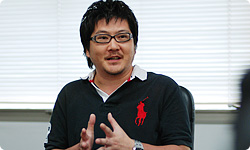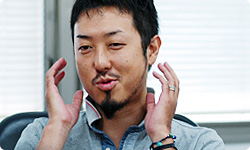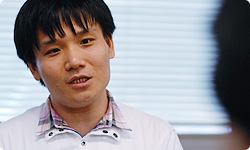4. 'Disconcertingly Well-connected'
We heard that the number of emails sent and received was over ten thousand, but while some people would be absolutely exhausted after sending that number of emails, other people are fine. While I’m sure you’re tired, of course, Nagasawa-san, meeting you today I don’t get the feeling that you got fed up of the ten-thousand-email exchange. Why is that?
For this project, Sakamoto-san named the production team ‘Project M’. Thanks to this, we were all able to communicate as equals, as members of the Metroid: Other M development team, despite the fact that we worked for different companies. I think this is why the communication did not become tiresome.
Saito-san told us earlier: ‘At first I thought I’d hate working in a ‘top-down’ system, but it turns out this was a needless worry’. You felt the same, then, Nagasawa-san?
Yes, I did. Basically, the relationship wasn’t one of some people doing the ordering and other people receiving orders. The members of the different companies worked together as a team, and so it was easy for us to voice our opinions too.
Not having a so-called ‘commanders and obeyers’ relationship means that things you don’t have yourself are provided by your partners in the team, and vice-versa. This means that the team develop respect for each other. In such a relationship, based on mutual respect, it is probably easy to bounce proposals and opinions off each other, isn’t it?
That’s right. As a result, there was absolutely nothing like ‘just do what you’re told’, and it was an environment where you could speak freely whenever you liked. I think everybody had the capacity to accept other people’s opinions in this way, so there was absolutely no stress involved in the exchanges.
The fact that you could say anything you wanted to say was also reflected in the length of the meetings. We’d all have a face-to-face meeting whenever something came up, for example.
I also said that ‘face-to-face communication is better, so if there is a need, it’s better not to hesitate in holding these meetings’. There are not many things for which it is better not to have a meeting than to have one. In this day and age, of course, there are a lot of things that can be done electronically, though.
Meetings that lasted six, seven or eight hours became relatively common.
Sometimes I’d eat twice in the space of one meeting! (laughs)
Eating twice, so... Two meals? My word.
I’d have lunch during a meeting. I’d also have dinner. Sometimes I’d even have the next day’s breakfast! (laughs)

Three meals! (laughs)
But even long meetings like that, far from feeling like tough going, were full of enjoyable parts.
This project team was made up of three parts: Nintendo’s Metroid team, Team NINJA, and the cinematic group that contained Nagasawa-san, Kitaura-san and others. This might seem like a strange combination to the outside world, but with a high volume of communication, you were able to exchange ideas and information smoothly. In game development, however, I don’t think it’s possible that everything always goes well and that you have nothing but happy times. I’d like to ask you about the times you thought ‘this is really tough going’. How was it for you, in charge of sound, Koike-san?
The development took place over a long period, so there were several tough times. For example, the very first thing we made available to the public on the website for this project was a piece of piano music . That piece started life one afternoon when we got a message from Sakamoto-san, saying ‘I want to make a piece of piano music’. After I responded ‘well, there’s somebody on my staff who can play the piano’, we decided to create the piece. Then when I asked him ‘when’s the deadline, by the way?’, he responded ‘today’.
...That’s rather unreasonable! (laughs)
(laughter)
It became one of those ‘this is tough going!’ times, that’s for sure. So we got the piano-playing member of staff to play for us. We made the first part, and then let Sakamoto-san listen to it before doing anything else.
Was Sakamoto-san in Kyoto at the time?
Yes, he was, so we sent the music as email attachments. Of course, Sakamoto-san is a bit of an obsessive, so his response upon listening to it was ‘this part is wrong’. So we did it again and resent it to him, and his response was ‘this part is wrong as well’. This kind of exchange continued over and over until about 8pm, and even the piano player started saying: ‘I just don’t understand!’.
So he was ready to admit defeat?
Yes, so I decided to join in and help him. We tried doing it with two chords, then one, and so on, steadily making the piece simpler and simpler. Then, at the end, we asked Sakamoto-san to listen to it. He said ‘it’s become really good. I’m moved...I could almost cry’. When I heard him say that I was incredibly happy. Though it was just one day’s work, it had been really heavy going. Then, just like that, everything was all right...

So you sampled heaven and hell in a day, it seems.
Oh, I sampled them, that’s for sure! (laughs) But this is not the end of the story. After everything was finished that day and after I got home I received a phone call from Sakamoto-san. Just as I was thinking ‘What could this be about?’, Sakamoto-san said ‘I heard a really great piece of music today. Thank you.’.
Ah, so that’s how moved Sakamoto-san was.Now the planner, Otsuka-san. You told us earlier about how Sakamoto-san hadn’t minced his words in showing you the flowers blossoming in your own garden, and how you couldn’t sleep that night. Apart from that, what other challenging times did you have?
As you can imagine, seamlessly connecting the game parts and the cinematic parts was very challenging. ‘Connecting the game and the cinematics’ sounds simple, but when we first met Sakamoto-san, I realised ‘If we just simply connect them up normally, it won’t be the least bit satisfying for him’.

So in order to connect the game parts and the cinematic parts to the required level, there were things you had to remake afresh, some things that you had not planned to make that you had to make additionally, and so on. A wide range of revisions needed to be made.
That’s right. In fact there were some things that had to be completely redone from the beginning. As a consequence of these large-scale revisions, however, our emotions were really stirred when we connected the cinematic parts and the game parts. Our staff also actually played the game, and after doing so one of them, a planner, came up to me and said ‘they’re so well-connected it’s disconcerting’.
‘Disconcertingly well-connected’! (laughs). When I think of Sakamoto-san’s obsessiveness, I feel that this game’s strengths are really expressed in that phrase. Nagasawa-san, as the one who was responsible for creating the cinematics, did you go through many tough times in order to connect them ‘disconcertingly well’?
Actually, there were many times when what we made after spending considerable time was rejected and sent back to us. We’d then make it again, only for it to be rejected and sent back to us, again.
Sakamoto-san’s obsession with ‘timing’, especially, is really something, isn’t it?
Oh yes, I really felt that.
Even in some of the cinematic production parts of the project, which are normally entrusted to someone else, there are times when he’ll jump in and intervene if he thinks something is important. I heard that during the last stages of this project, he got deeply involved with adjusting the ‘space’ – that is, the timing - of the frames in the cinematics.
There were actually many times when he’d look at a cinematic we’d created and have no particular comments to make, so we’d relax and think ‘this one’s OK’. After a little while, though, we’d inevitably get an email... Furthermore, it was technically Kitaura-san that he should have been communicating with, but I was the one getting the emails.
So he was coming to you with all the things he couldn’t say to Kitaura-san, Nagasawa-san? (laughs)
Yes, it would appear so. (laughs) And those emails always had one innocent subject: ‘A Consultation.’
Those emails would require quite a bit of special attention when they arrived, then.
Yes, so I’d read them really, really carefully. They’d be about a cinematic he’d watched a while earlier, and he’d write extremely detailed things in order to make minute changes in very specific segments with regards to how many split-seconds or even less there should be before moving to the next sequence, like ‘I want it to be like this after all’ or ‘reduce the sense of tension here a little bit’.
I suppose this was because Samus’s thoughts and feelings couldn’t have been properly depicted without detailed adjustments being made.
Yes. From the middle of the project onwards, Samus was gradually entrusted to Kitaura-san, but there were times when Kitaura-san’s production image of ‘I want Samus to be like this’ and Sakamoto-san’s original image of ‘Samus is like this’ would be in conflict. It wasn’t a case of one or the other being correct, of course.
When you have obsessive types on both sides, there will be times when they’ll say ‘this is fantastic’, and other times when they’ll say ‘this is wrong’.
Exactly. That’s why we’d deal with even a single expression by adjusting individual frames. By repeatedly making very minute adjustments - for example, making Samus’s eyes flicker in the first frame and moving her mouth a little in the third – we’d search for expressions for Samus that would match both of their images. Increasing the physical quality in such extremely detailed ways was really tough going.
